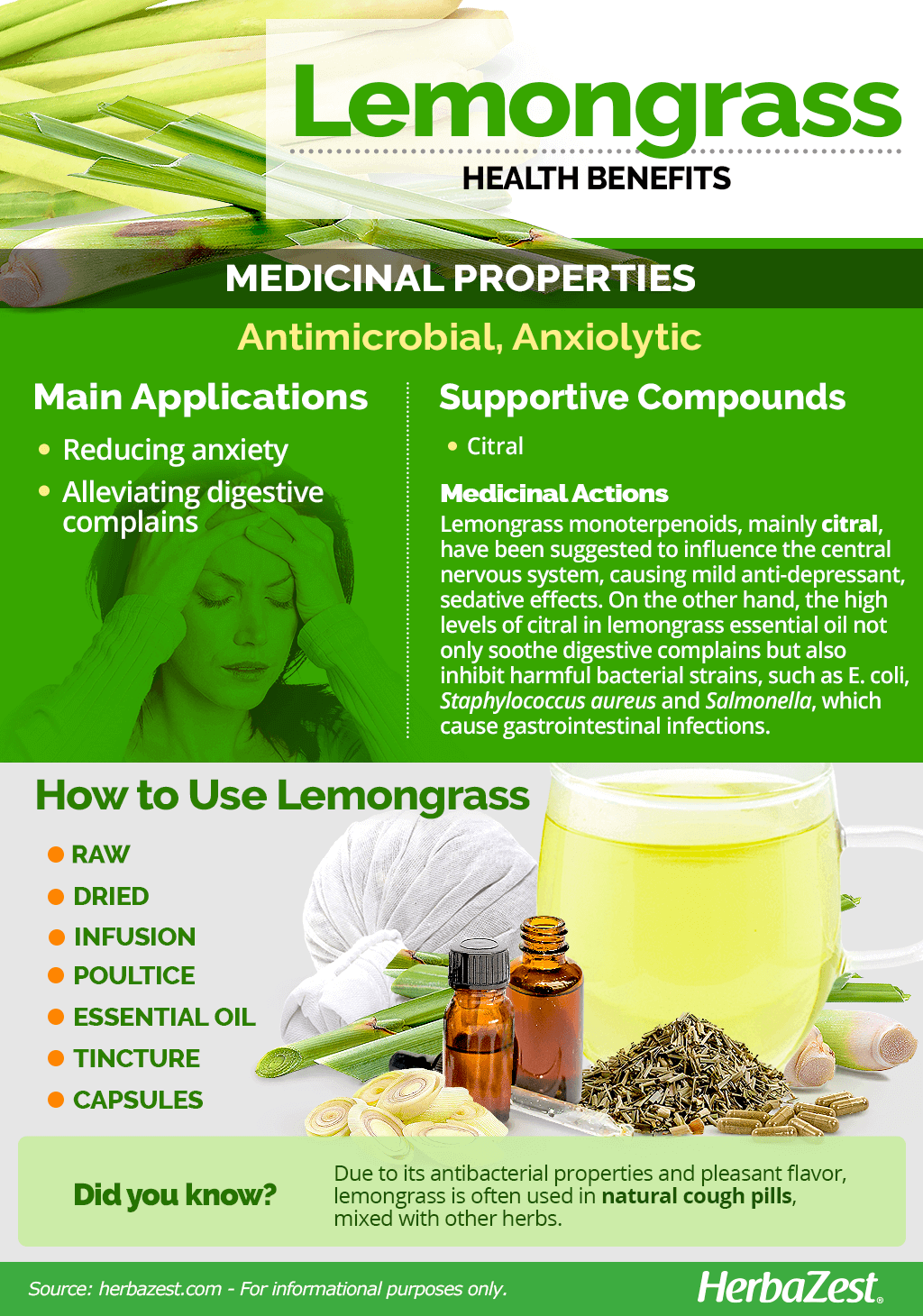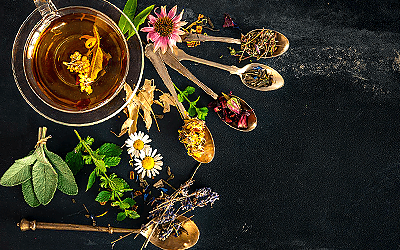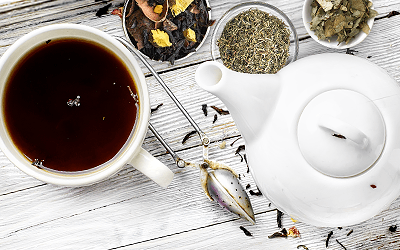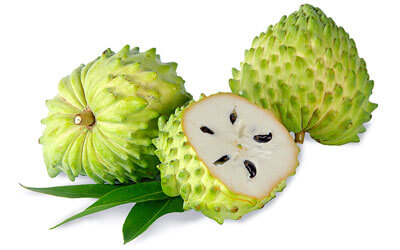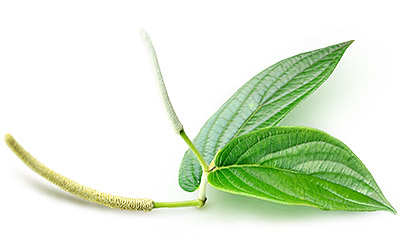Lemongrass has been cultivated for centuries and used as a flavoring in food, a scent for aromatherapy, and an ingredient in medicinal applications. It is a very common ingredient in Asian cuisine, and its pleasant, citrusy scent is used both in candles and as an insect repellent.
Lemongrass Medicinal Properties
Health Benefits of Lemongrass
The sedative and anti-inflammatory properties of lemongrass have found several medicinal uses:
Reducing anxiety. The sedative properties of lemongrass have been popularly used to induce relaxation and sleep.
Alleviating digestive complains. Lemongrass properties have been shown to inhibit the bacterial strains that cause symptoms of gastrointestinal stress, such as colic, gas, diarrhea, and vomiting.
Well-known lemongrass benefits also include treating the symptoms of common cold, reducing inflammatory pain, and eliminating fungal infections.
LEMONGRASS HAS PROVEN EFFECTIVE FOR RELIEVING HEADACHES AND ARTHRITIC PAIN AS WELL AS FOR STABILIZING BLOOD SUGAR AND CHOLESTEROL LEVELS.
How It Works
The health properties of lemongrass come from monoterpenoids, mainly citral, which is composed of the two isomers, geranial and neral. Both of these isomers have a strong citrus odor, lending citral its usefulness as a flavoring and as a scent.
Lemongrass essential oil concentrates the anxiolytic properties of the herb, and its monoterpenoids (mainly citral) have been suggested to influence the central nervous system by binding to the same receptor of gamma-aminobutyric acid (GABA) targeted by a group of psychoactive drugs called benzodiazepines, causing mildly anti-depressant, sedative effects.1,2
The analgesic and antimicrobial activities of lemongrass have been attributed to its high citral content, which has been shown to soothe digestive complains as well as inhibiting harmful bacterial strains, such as E. coli, Staphylococcus aureus and Salmonella.3,4,5,6
Citronella oil, which is made from a particular variety of lemongrass, owes its repellent properties and smell to three compounds: geraniol, citronellol, and citronellal.
Similar antimicrobial properties can be found in herbs like calendula, coconut, and lime, whereas lemon balm, rhodiola, St. John's wort, and valerian also have sedative effects.
Lemongrass Side Effects & Cautions
Lemongrass is generally considered safe for oral consumption; however, topical applications may trigger allergic reactions in people with certain sensitivities.
Since there's no information on the safety of lemongrass during pregnancy and lactation, it is recommended to consume the herb only in culinary amounts during this period.
- Medicinal action Antimicrobial, Anxiolytic
- Key constituents Citral
- Ways to use Hot infusions/tisanes, Liquid extracts, Food
- Medicinal rating (2) Minorly useful plant
- Safety ranking Safe
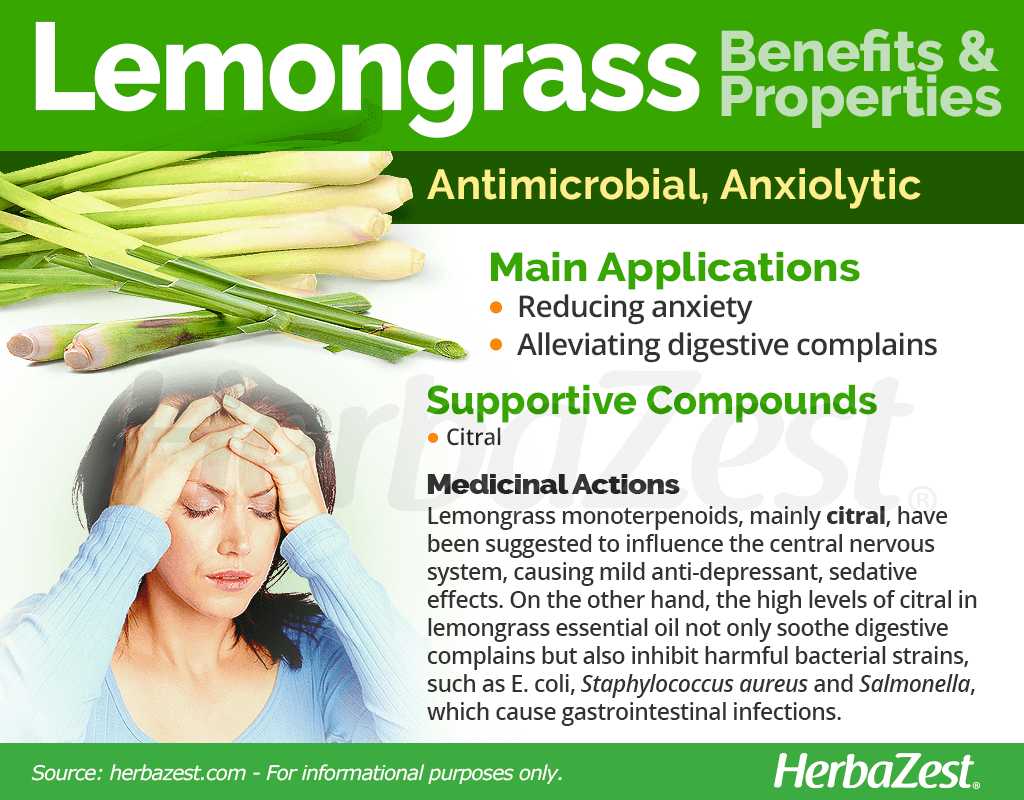
How to Consume Lemongrass
Lemongrass has a bright, fresh citrus taste, which is appreciated in Asian dishes. It can be steeped like tea or used to flavor preparations. Similarly to a bay leaf, it is removed before eating. Chopped small, the leaves will add a lively zing to main dishes.
Natural Forms
Raw. The fresh leaves and hard stalks of lemongrass can be steeped into teas, soups, sauces, and curries for a bright, lemony flavor. They can also be made into hot infusions and home remedies as well as for flavoring beverages.
Dried. The dried leaves of lemongrass can be used to flavor many dishes as well as brew herbal infusions.
Infusion. The fresh or dried leaves of lemongrass can be stepped in hot water in order to obtain a warm infusion that can be taken for soothing the nerves, calming an upset stomach or relieving fever.
Poultice. The freshly crushed leaves and stems of lemongrass can be applied topically as a poultice in order to relieve joint and muscle pain.
Herbal Remedies & Supplements
Essential oil. Mostly used in aromatherapy for its anxiolytic properties, lemongrass essential oil is also an analgesic agent, which can be applied topically in order to relieve muscle and joint pain.
Tincture. This concentrated form of lemongrass needs to be diluted in water and acts as a mild sedative. It is often used for treating insomnia, stress, and stomach discomfort.
Capsules. The dried and pulverized leaves of lemongrass are often commercialized in capsules and taken to relieve stomach complains and joint pain as well as to balance cholesterol levels.
Due to its antibacterial properties and pleasant flavor, lemongrass is often used in natural cough pills, mixed with other herbs.
- Edible parts Leaves, Stem
- Edible uses Flavoring, Beverage
- Taste Aromatic, Sweet
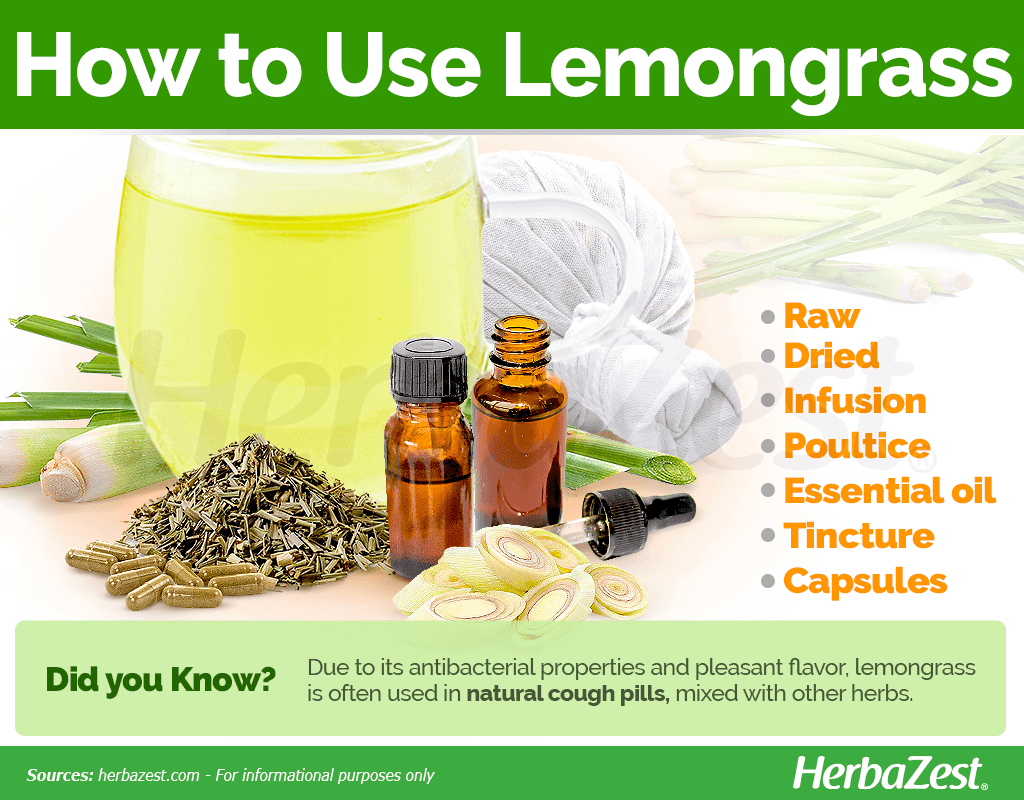
Growing
Lemongrass is a perennial herb that can grow in a wide variety of soils and climates. It can be planted in a pot and grows very well inside or outdoors. Although it is a hardy plant, lemongrass thrives under a particular set of conditions and requires some basic care.
Growing Guidelines
Lemongrass prefers warm, humid climates. It grows well at a temperature range of 50 - 92°F (10 - 33°C), and it needs enough sunshine for the development of oil in the plant. The grass is sensitive to cold weather and cannot withstand frost.
Lemongrass is widely adapted to a range of soils and performs well on sandy to clay loam soils with a pH range of 5,0 to 8,4, and good drainage.
Lemongrass usually grows by slips obtained by dividing well-grown clumps. The tops of the clumps should be cut off within 8 - 10 inches (20 - 25 cm) of the root. The latter should be divided into slips and the lower brown sheath should be removed to expose young roots. For home production, a stalk of lemongrass, even one from the grocery store, may be placed in a glass of water and roots will grow within a few weeks.
For agricultural production, a row spacing of eight inches (20 cm) with a row width of 16 inches (40 cm) will give a total of 125,000 plants per hectare in a high rainfall area, or under irrigation. In areas with lower rainfall, 60,000 plants per hectare is an advisable density.
Planting of slips can be done as soon as the active growing season starts and during most times of the year when soil moisture is sufficient. Avoid planting during very hot times of the year and during winter, when plants are usually dormant
Stalks can be harvested any time after they reach at least 0.5 inches (12.5 mm) thick. To do so, the blade should be cut at ground level, right above the base. The entire stalk can be used either fresh or dried and will last for quite some time after cutting. Lemongrass is a relatively hardy plant and shouldn't take too much to flourish.
The stem-boring caterpillar (Chilotrea) is the most common pest attacking lemongrass in Southeast Asia. The caterpillar is white, with a black head, and has black spots on the body.
- Life cycle Perennial
- Harvested parts Rhizome, Leaves
- Light requirements Full sun
- Soil Medium (loam)
- Soil pH 5.1 – 5.5 (Strongly acidic), 5.6 – 6.0 (Moderately acidic), 6.1 – 6.5 (Slightly acidic), 6.6 – 7.3 (Neutral), 7.4 – 7.8 (Slightly alkaline)
- Growing habitat Humid regions, Subtropical regions
- Planting time Spring, Late summer, Fall
- Plant spacing average 0.25 m (0.82 ft)
- Propagation techniques Stem cuttings
Additional Information
Plant Biology
Lemongrass (Cymbopogon citratus), native to Indonesia and common in most of the tropics, including Africa and South America, is a grassy, fragrant tuft widespread within its natural range. It also occurs in cultivation.
Lemongrass grows in dense clumps up to seven feet (2 m) in diameter and has leaves up to three feet (1 m) long. Its leaves are smooth and hairless, white on the upper surface and green beneath. The flower of lemongrass is a loose, nodding panicle, about 24 inches (60 cm) long and reddish to russet in color. The hard stalks are tinged with purple.
Classification
Cymbopogon citratus is a perennial plant, member of the Poaceae family, also known as Gramineae or true grasses, the fifth-largest plant family, with over 10,000 varieties, both wild and domesticated. Some of the most economically valuable crops in the world make part of this family, notably including: maize, millet, oat, rice, sugarcane, and wheat.
Varieties and Subspecies
The Cymbopogon genus comprises approximately 50 species of grasses. After Cymbopogon citratus, which does not have any varieties or subspecies, the main species are C. nardus - the source of citronella oil -, C. martinii, and C. winterianus.
The botanical name of lemongrass, Cymbopogon, is believed to come from the Greek kymbe, meaning 'boat', and pogon, meaning 'beard', in reference to the shape of lemongrass tiny flowers.
Historical information
Lemongrass has been used since ancient times for ritualistic and healing purposes, and plenty of references to the herb have been found in Sanskrit manuscripts and the Bible. Thanks to these historical records, it is known that lemongrass was ubiquitous throughout northern India and the Middle East, including the region along the Nile river, today's Egypt, Sudan, and Ethiopia.
It is said that the first sample of citronelle oil was introduced to Europe in 1717 from the Maluku Islands in eastern Indonesia, establishing a prosperous trade route during over 100 years. However, with the emergence of the industrial distillation of essential oils in 1820, the discovery of synthetic fragrances reduced the need for aromatic herbs. Nowadays, the industry of perfumery and aromatherapy has created new markets for lemongrass.
Popular Beliefs
One species of lemongrass (Cymbopogon densiflorus) is used by medicine men in Tanzania as a smoke that it is thought to induce fortune-telling dreams.
Economic Data
India is the largest producer of lemongrass with about 80% of the produce being exported, mostly to West Europe, U.S.A., and Japan. Madagascar, Zambia, Guatemala, Mexico, China, and Sri Lanka also cultivate lemongrass on a large scale.
The world production of lemongrass oil is about 661 tons (600 tonnes) annually. North America represents about 33% of the global demand and Japan accounts for 10%.
Other Uses
Aromatherapy. Aromatherapists use the fragrant lemongrass essential oil for relaxation.
Beverage industry. Lemongrass is commonly used for flavoring commercial beverages as well as an starting material for manufacturing ionones, which produce vitamin A.
Cosmetics. Lemongrass essential oil, which is composed of over 75% of citral, is a common ingredient for perfumes, creams, soaps, and other personal care products.
Gardening. Its powerful, natural pheromone works well as an agent for both attracting bees and warding off insects (instead of synthetic pesticide). It is also often planted as an ornamental weed.
Repellent. Due to its high content of citral, lemongrass is used to manufacture insect repellent candles.
- Other uses Cosmetics, Perfume, Repellent, Soapmaking
Sources
- American Herbal Products Association's Botanical Safety Handbook, p. 298
- Applied Microbiology and Biotechnology, Antimicrobial activity, cytotoxicity and chemical analysis of lemongrass essential oil (Cymbopogon flexuosus) and pure citral, 2016
- Essential Oil Crops, Lemongrass Production. pp. 5 - 9
- Herbal Medicine and Botanical Medical Fads, p. 149
- Journal of Applied Microbiology, Antimicrobial activity of lemongrass oil against Salmonella enterica on organic leafy greens, 2011
- National Horticultural Board - India, Horticulture Crops, Lemon Grass
- Purdue University, Lemongrass
- Scientific Research Council - Jamaica, Investment Opportunity- Extraction of Lemon Grass Oil
- The Desktop Guide to Herbal Medicine, p. 262
- The Encyclopedia of Herbs and Spices, p. 547
- The Journal of Clinical Psychiatry, The GABA-benzodiazepine receptor complex: structure, function, and role in anxiety, 2005
- The Story of Food: An Illustrated History of Everything We Eat, p. 333
- University of Florida, A pharmacognostical study of the origin of lemongrass oil
- Utah State University, Lemongrass in the Garden
- Encyclopedia of Natural Medicine, p. 198
- Medicinal Plants of the World, p. 120
- Kew Royal Botanic Gardens, Cymbopogon citratus (lemon grass)
Footnotes:
- Journal of Alternative and Complementary Medicine. (2015). Effect of Lemongrass Aroma on Experimental Anxiety in Humans. Retrieved May 11, 2022 from: https://pubmed.ncbi.nlm.nih.gov/26366471/
- Journal of Ethnopharmacology. (2011). The GABAergic system contributes to the anxiolytic-like effect of essential oil from Cymbopogon citratus (lemongrass). Retrieved May 11, 2022 from: https://pubmed.ncbi.nlm.nih.gov/21767622/
- Journal of Applied Microbiology. (2015). Antimicrobial effect of lemongrass oil against oral malodour micro-organisms and the pilot study of safety and efficacy of lemongrass mouthrinse on oral malodour. Retrieved May 11, 2022 from: https://pubmed.ncbi.nlm.nih.gov/25327222/
- Libyan Journal of Medicine. (2014). Lemon grass (Cymbopogon citratus) essential oil as a potent anti-inflammatory and antifungal drugs. Retrieved May 11, 2022 from: https://www.ncbi.nlm.nih.gov/pmc/articles/PMC4170112/
- Frontiers in Cellular and Infection Microbiology. (2020). Antimicrobial Activity of Lemongrass Essential Oil (Cymbopogon flexuosus) and Its Active Component Citral Against Dual-Species Biofilms of Staphylococcus aureus and Candida Species. Retrieved May 11, 2022 from: https://www.ncbi.nlm.nih.gov/pmc/articles/PMC7783362/
- Journal of Young Pharmacists. (2012). Investigation of the Mechanisms Underlying the Gastroprotective Effect of Cymbopogon Citratus Essential Oil. Retrieved May 11, 2022 from: https://www.ncbi.nlm.nih.gov/pmc/articles/PMC3326778/
